A Photographer’s
Magical Humanism
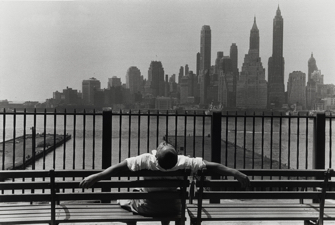
“Manhattan from the Brooklyn Promenade” (1954). © Centre Pompidou/Dist. RMN-GP. © Louis Stettner
Over the years, I’ve ping-ponged between Paris and New York, taking advantage of these highly photogenic and oft-photographed cities’ remarkable museums and galleries. Their many exhibitions of renowned French and American photographers provided me with a layman’s education in 20th-century photography. For all of these reasons, I was ashamed that I had never heard of Louis Stettner.
At the age of 94 – and still working – Stettner himself has been ping-ponging across the Atlantic for decades. Born in Brooklyn in 1922, he first discovered Paris in the aftermath of World War II (he served as a soldier in the Pacific) and since then has been capturing day-to-day life on the streets of both metropolises with a black-and-white lyricism that immediately strikes a chord.
It struck one with me when I logged onto the Centre Pompidou website to check out hours for the current Paul Klee exhibition. I was immediately sidetracked by an arresting photo of a bare-torsoed Spanish fisherman up to his
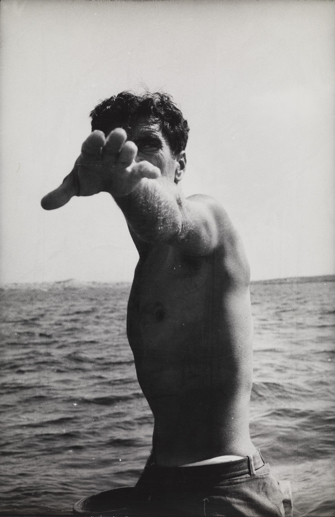
“Tony” (1956), from the series “Pepe and Tony, Spanish Fishermen.” © Centre Pompidou/Dist. RMN-GP © Louis Stettner
waist in a black-and-white Mediterranean, his face partially covered by his hand as his arm lunges at the camera. It was on show in “Louis Stettner: Here There,” a retrospective of the photographer’s work that covers an incredible eight decades of work.
Along with his mentor, Lewis Hine, Stettner is an adept of what is known in America as “street photography” and in France as “humanisme.” The one-room Pompidou exhibition begins with Stettner’s physical and photographic
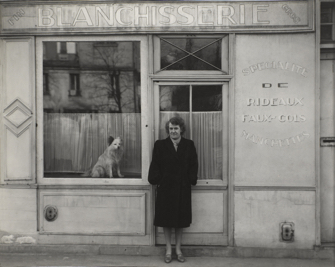
“Laundry Woman In Front of Her Shop, Paris” (1949). © Centre Pompidou/Dist. RMN-GP. © Louis Stettner
arrival in Paris, where his lens captured the velvety shadows and soft pearly tristesse of postwar streets and their gradual blossoming into the gayer Paris of the 1950s.
Like his contemporary and cohort, Brassaï, Stettner saw humanism as a means of interpreting the world around him: “Not coming with a preconceived idea but discovering something more… The Other: that’s what has always fascinated me.”
The “Others” Stettner tumbles upon vary from elderly British tourists strolling through Parisian streets to public-transport passengers
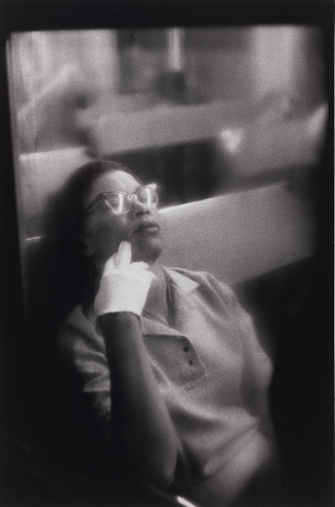
“Woman with White Gloves” (1958), from the series “Penn Station.” © Centre Pompidou/Dist. RMN-GP. © Louis Stettner
– weary, dreamy and unaware of the photographer’s Rolleiflex as he captures them on dimly lit New York subways and trains at Penn Station.
Later, Stettner – a self-declared Marxist – focused increasingly on working men and women in a pioneering attempt to subvert the cliché of laborers as rough brutes and to reveal the beauty of humans engaged in everyday
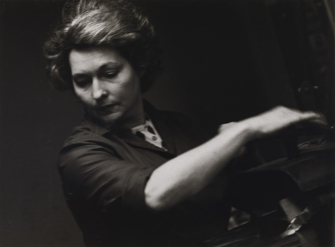
“Ouvrière dans une Imprimerie, France,” from the series “Workers” (1972-74). © Centre Pompidou/Dist. RMN-GP. © Louis Stettner
activities: waitresses, metalworkers, and the Ibiza fishermen Pepe and Tony, whose forays at sea he transformed into a book (the galleys of the never-published tome are on display).
Although considered suspect in the United States because of his Leftist leanings, Stettner’s portraits (honoring Cartier-Bresson’s “decisive moment,” many were taken on the spur of the moment without the subjects’ knowledge) gracefully eschew propaganda in favor of poetry. Patterns and parallels abound in the unerring compositions, while Stettner’s attention to atmosphere, particularly degrees of light, imbues reality with a chimerical sheen.
Many of the photos are as beautiful as the moments they capture: An elderly man in an Île Saint-Louis bistro on Christmas Eve,
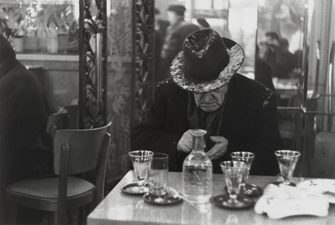
“Christmas Eve, Île Saint Louis” (1950-51). © Centre Pompidou/Dist. RMN-GP. © Louis Stettner
delicate flakes of snow speckling his black fedora. A pair of Texan women with sky-high bouffants standing side-by-side on Fifth
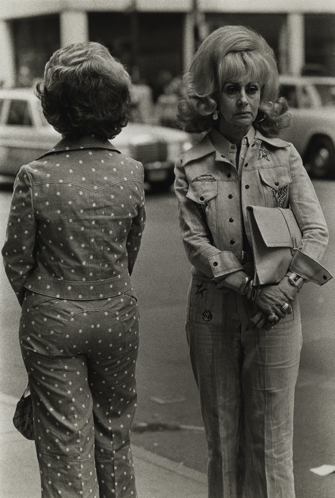
“Texans on Fifth Avenue” (1975) © Centre Pompidou/Dist. RMN-GP © Louis Stettner
Avenue, one facing the camera and the other with her back turned, like two sides of the same person. And perhaps Stettner’s most recognized photo (at the top of this page): a man seated on a Brooklyn Heights bench, his face arched up to the sun, his arms stretched out in Christ-like surrender against the Lower Manhattan skyline.
Coincidentally, I had first seen this photo a day earlier in the windows of the Galerie David Guiraud as I wandered through the Marais. It turns out that Guirard represents Stettner in Paris and invited the photographer to curate an exhibition of his own work, “Louis Stettner: Les Favorites.” As Guirard pointed out, “Les Favorites” serves as both as a complement and appetizer to the Pompidou show, a sort of Greatest Hits assortment of Stettner’s work (including two striking recent color images) from which the museum’s larger show branches out in myriad directions.
At both shows, Stettner’s personal presence is strong (he attended both openings). As in all the best photographic work, one comes away with a strong sense not only of the photo’s subjects, but also of the person behind the camera. This is underscored at the Pompidou show, where thematic and chronological groupings of photos are accompanied by first-person reflections penned by Stettner himself. One of these texts sums up his views on photography as a “gift that nobody gives… An anonymous gift.” Viewers who see these shows will likely walk away feeling as if they, too, have received a unique gift.
Centre Pompidou: 19, rue Beaubourg, 75004 Paris. Tel.: 01 44 78 12 33. Open 11am-9pm. Closed Tuesday. Métro: Rambuteau. Admission: free. Through September 12, 2016. www.centrepompidou.fr
Galerie David Guiraud: 5, rue du Perche, 75003 Paris. Métro: Filles du Calvaire or Saint Sébastien Froissart. Tel.: 01 42 71 78 62. Open Tuesday-Saturday, 2:30pm-7pm. www.galerie-david-guiraud.com
Reader reaction: Click here to respond to this article (your response may be published on this page and is subject to editing).
More reviews of Paris art shows.
© 2016 Paris Update
Favorite